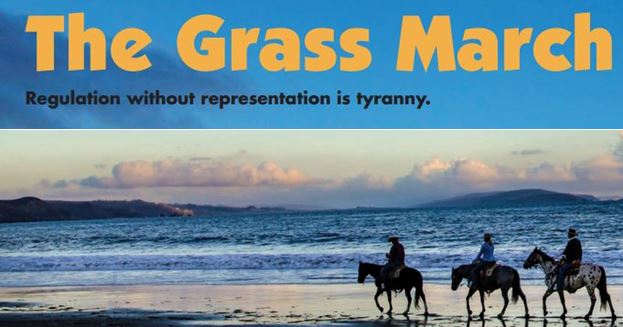The only thing that makes a conspiracy illegal is an unlawful purpose or objective.
Bearing the whole judicial transparency issue in mind, in this piece I’m going to follow-up on some previous thoughts. In one of my previous columns, I had mentioned that with the degree of  electronic surveillance that is going on in these cases, the federal government had supposedly employed a “taint team” or a “filter team” as it has also been referred to, to ensure that prosecutors did not have access to privileged or otherwise improper information, like attorney/client communications, resulting from the extraordinary degree of electronic monitoring which is occurring in these cases. But this week, unsurprisingly, it became clear that the filter team apparently hasn’t been doing its job, which resulted in objections to evidence the Government had improperly disclosed and sought to include at trial. Judge Brown requested the Government to explain how and why this had happened, but after an assistant U.S. Attorney, an FBI agent, and several paralegals all testified about the filtering process and what they had done, and attempted to satisfactorily explain what happened, Judge Brown found that information they were seeking to introduce as evidence exceeded the scope of the Government’s “Facebook Search Warrant.” In the end Judge Brown requested further explanations, and it is still unclear what the net effect of all this will be. But it is an interesting development, particularly in light of the fact that so much of the Government’s case is built on social media evidence.
electronic surveillance that is going on in these cases, the federal government had supposedly employed a “taint team” or a “filter team” as it has also been referred to, to ensure that prosecutors did not have access to privileged or otherwise improper information, like attorney/client communications, resulting from the extraordinary degree of electronic monitoring which is occurring in these cases. But this week, unsurprisingly, it became clear that the filter team apparently hasn’t been doing its job, which resulted in objections to evidence the Government had improperly disclosed and sought to include at trial. Judge Brown requested the Government to explain how and why this had happened, but after an assistant U.S. Attorney, an FBI agent, and several paralegals all testified about the filtering process and what they had done, and attempted to satisfactorily explain what happened, Judge Brown found that information they were seeking to introduce as evidence exceeded the scope of the Government’s “Facebook Search Warrant.” In the end Judge Brown requested further explanations, and it is still unclear what the net effect of all this will be. But it is an interesting development, particularly in light of the fact that so much of the Government’s case is built on social media evidence.
The next issue I want to discuss is the Adverse Possession defense that has been asserted by Ammon Bundy’s attorneys. In a nutshell, according to Cornell University’s Legal Information Institute:
“Adverse possession is a doctrine under which a person in possession of land owned by someone else may acquire valid title to it, so long as certain common law requirements (open, notorious, hostile possession) are met, and the adverse possessor is in possession for a sufficient period of time.”
As I mentioned in a previous piece, Judge Robert Jones summarily rejected that argument, and quickly stated that an adverse possession claim cannot be asserted against the Federal Government. Therefore, according to his ruling, Bundys would not even be allowed to present evidence regarding the Adverse Possession theory at trial. Without taking time to thoroughly research Judge Jones’ assertion at the time, it struck me that he was a little too hasty in his rejection of that theory.
 Since then, however, Ammon Bundy’s attorneys have requested reconsideration of that decision, and Bundy’s former attorney, Mike Arnold, has written an interesting and thought-provoking article about the adverse possession theory, and Judge Jones’ treatment of it, despite specific federal statutes acknowledging application of the theory under certain circumstances.
Since then, however, Ammon Bundy’s attorneys have requested reconsideration of that decision, and Bundy’s former attorney, Mike Arnold, has written an interesting and thought-provoking article about the adverse possession theory, and Judge Jones’ treatment of it, despite specific federal statutes acknowledging application of the theory under certain circumstances.
While many have said that they do not believe that Ammon Bundy could mount a legitimate and successful affirmative Adverse Possession claim at the Refuge, to a large extent, they are missing the point. The point is, in a criminal case like this one, Adverse Possession is not being asserted as some kind of affirmative claim theory, but is being asserted as a defense – a defense seeking to provide evidence of an alternative purpose, intent and state of mind.
Let me explain how this works. The Malheur Refuge Defendants have been charged with conspiracy to impede a federal officer. Conspiracy charges are all about intent. The reality is, a conspiracy is nothing more than an agreement. Almost all surprise birthday parties, for example, result from a  conspiracy to have a surprise party. People are conspiring continually, to do all kinds of perfectly legal things. Have you ever conspired to pull a prank or to play a practical joke? Men and women often conspire to conceive children – or to simply engage in acts that can lead to conception of children. It is entirely possible to conspire to do good, perfectly legal things. It happens all the time. Lawmakers are continually conspiring to pass legislation. Each and every plea deal entered into by any of the defendants in the Oregon Standoff cases was the result of a conspiracy by the prosecutors and defense attorneys – for the defendant(s) in question to enter into a plea agreement, rather than go to trial.
conspiracy to have a surprise party. People are conspiring continually, to do all kinds of perfectly legal things. Have you ever conspired to pull a prank or to play a practical joke? Men and women often conspire to conceive children – or to simply engage in acts that can lead to conception of children. It is entirely possible to conspire to do good, perfectly legal things. It happens all the time. Lawmakers are continually conspiring to pass legislation. Each and every plea deal entered into by any of the defendants in the Oregon Standoff cases was the result of a conspiracy by the prosecutors and defense attorneys – for the defendant(s) in question to enter into a plea agreement, rather than go to trial.
While the word “conspiracy” seems to have negative connotations, such connotations are generally unfounded and misguided. The only thing that makes a conspiracy illegal, immoral, or unethical, is the purpose or intent of the agreement. Illegal conspiracy is all about illegal purpose, intent and state of mind. The only thing that makes conspiracy illegal is an unlawful purpose or objective.
In the Malheur Refuge cases, the primary charge is Conspiracy to Impede a Federal Officer. This means that in order to prove its case, the Government must show that the Defendants specifically intended to impede federal officers, and that at least some of them must have entered into an express agreement to do so. Arguments have been made that the conspiracy statute is unconstitutionally void for vagueness. That is a legal issue that will probably have to be resolved on appeal. In the meantime, let’s assume, at least for purposes of this discussion, that the statute is valid.
 And this is where the Adverse Possession defense enters into the picture. As with many agreements and so-called conspiracies, there can be more than one purpose. Ammon Bundy’s attorneys are seeking to present evidence and arguments that the primary purpose or objective of the Malheur Occupation, and any associated “conspiratorial agreement(s)”, were actually to stake an Adverse Possession claim at the Refuge. They assert that there is plenty of evidence to support this position. Whether such an attempt was well-founded and/or would have ultimately been successful is not even the question when the theory is raised as a defense. The question is what was their purpose and intent? Was it to impede federal officers, or was it to stake an Adverse Possession claim? Or was it both?
And this is where the Adverse Possession defense enters into the picture. As with many agreements and so-called conspiracies, there can be more than one purpose. Ammon Bundy’s attorneys are seeking to present evidence and arguments that the primary purpose or objective of the Malheur Occupation, and any associated “conspiratorial agreement(s)”, were actually to stake an Adverse Possession claim at the Refuge. They assert that there is plenty of evidence to support this position. Whether such an attempt was well-founded and/or would have ultimately been successful is not even the question when the theory is raised as a defense. The question is what was their purpose and intent? Was it to impede federal officers, or was it to stake an Adverse Possession claim? Or was it both?
The Government has the burden of proof. In order to prove its case, the Government must satisfy its burden of showing that there was a conspiratorial agreement between the parties, and that at least one of the express or primary purposes of that agreement was to impede federal officers. If there was another primary purpose (such as Adverse Possession), it will not be enough to simply claim or even show that impeding federal officers was a corollary, unintended consequence of their otherwise arguably lawful conspiracies and actions.
Now we’re getting down to the real nub of this issue. From what I understand, Judge Jones ruled that the Defendants can’t even assert an Adverse Possession defense or present any evidence to support it. For some time, I have been threatening to write a piece about the fox guarding the henhouse in the federal court system. And this particular issue is a good example of what I’m talking about. If the trial court will not even allow the Defendants to assert this legal theory as a defense, this could be viewed as a very legitimate example of arguable fox guarding the henhouse in this case.
 Experience demonstrates that this is an issue worth exploring. Several years ago in a high profile Utah federal case with some similarities, San Juan County Commissioner Phil Lyman was likewise charged with conspiracy — to operate a motor vehicle in a closed area on BLM land. He was charged with both conspiracy to engage in such trespass, and actually doing so. Hypothetically, even if he hadn’t actually engaged in such alleged trespass, he could have still been charged with, and convicted of, conspiracy — if it could be proven that is what he intended to do, and that he entered into a conspiratorial agreement to do so – whether carried out or not.
Experience demonstrates that this is an issue worth exploring. Several years ago in a high profile Utah federal case with some similarities, San Juan County Commissioner Phil Lyman was likewise charged with conspiracy — to operate a motor vehicle in a closed area on BLM land. He was charged with both conspiracy to engage in such trespass, and actually doing so. Hypothetically, even if he hadn’t actually engaged in such alleged trespass, he could have still been charged with, and convicted of, conspiracy — if it could be proven that is what he intended to do, and that he entered into a conspiratorial agreement to do so – whether carried out or not.
According to a variety of sources, the resulting Lyman prosecution itself was likewise the result of conspiracy and collusion between the Federal Government and a variety of Environmental Advocacy Groups. Unfortunately, the full extent of that collusion did not fully come to light until after the trial was already over, after which Utah District Court Judge Robert Shelby was recused from further involvement in the case, prior to sentencing, based on his close personal relationship with some of the head figures in the Southern Utah Wilderness Alliance, who were actively involved in the whole collusion to prosecute Lyman.
But that’s not the end of the story. After Judge Shelby was recused, the case bounced around half the Utah Federal District Court bench, with one judge after another recused, based on close connections to either environmental interests or the BLM. In the end four judges ended up being recused. Finally, the case came to rest with Chief Judge David Nuffer. Although Judge Nuffer apparently didn’t feel compelled to recuse himself (and it is unclear if the issue was even raised with respect to him), Nuffer’s previous law firm, Snow, Nuffer, Engstrom & Drake, likewise had very close ties to environmental advocacy groups, particularly including the Grand Canyon Trust. Nuffer’s fellow founding attorney/partner, Steven Snow, had served on the board of trustees of the Grand Canyon Trust, including at least one stint as chairman of the board, before stepping down when he was asked to serve as a “general authority” for the LDS Church.
Bringing the fox/henhouse issue full circle, at the very least it appears that Oregon federal judges are predisposed to reject the Adverse Possession theory without even allowing it to be presented at trial. That is a question of law that is highly appealable for legal correctness, with no deference to the trial court’s decision.
 On that basis, if that happens, I’m going to make a prediction right now: If the trial court refuses to even allow evidence and arguments regarding the Adverse Possession defense to be presented at trial, my prediction is the case is already headed for an appeal. And my further prediction is that decision would be reversed on appeal, with the case remanded back to the trial court for a new trial, allowing admission of the Adverse Possession defense and supporting evidence.
On that basis, if that happens, I’m going to make a prediction right now: If the trial court refuses to even allow evidence and arguments regarding the Adverse Possession defense to be presented at trial, my prediction is the case is already headed for an appeal. And my further prediction is that decision would be reversed on appeal, with the case remanded back to the trial court for a new trial, allowing admission of the Adverse Possession defense and supporting evidence.
Rumor has it that the Department of Justice has allocated a full hundred million dollars to try these cases. Who knows how much the appeal(s) will cost? And what about a retrial? Those are the kinds of questions people begin to ask when they start trying to read the tea leaves, and the writing on the wall.
Once again, if all this leaves you scratching your head, you’re not the only one.
RANGE / RANGEFIRE — Addressing Issues Facing the West / Spreading America’s Cowboy Spirit Beyond the Outback




Good work. Keep it up. Oregon is 50 years behind the common law, and with the executive and judicial infrastructure running exclusively by nepotism, cronyism, and ignorance, they both will do whatever they can get away with, mostly not realizing that there is a Constitution and a notion of the Rule of Law.
Great insight, Todd. Thanks for your public service of educating the public with your legal opinions.